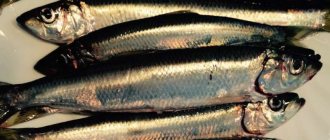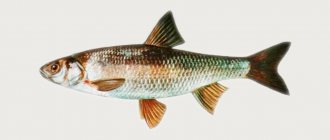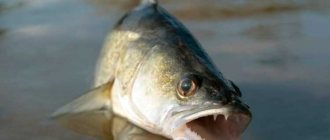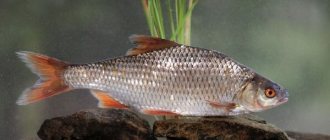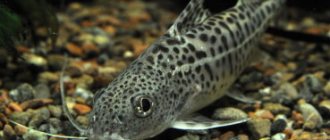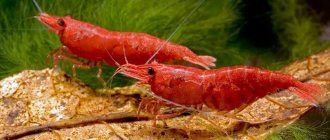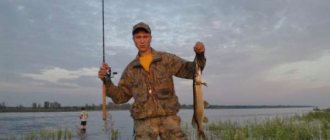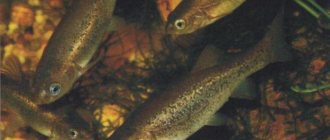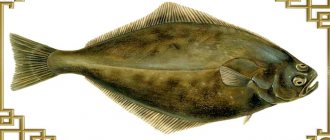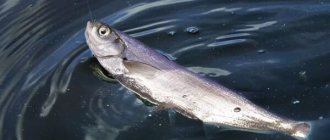Appearance and characteristics
Due to the fact that the fish has an expressive appearance, it is very difficult to confuse it with other species. The ruffe has a large head, large pale pink eyes and a mouth with bristle-like teeth. The body of the fish is dense, cylindrical in shape, covered with mucus. There are wide gill covers with spines. There are also small ctenoid-type scales on the surface.
There are gray-green spots and dots on the back. The sides are yellowish. The belly may be light gray or white, depending on environmental conditions. For example, fish that live on a sandy bottom are lighter in color than those that live in areas of reservoirs with a muddy bottom.
The length of an adult individual reaches an average of 10 centimeters. Occasionally there are fish 12 centimeters long. Weight is small - 15-25 grams. But it is quite possible to catch giant specimens, 20 centimeters long and weighing 100 grams.
Lifestyle
Ruffs have an unpretentious lifestyle. Fish can live in a wide range of depths. Despite the fact that they prefer to live near the bottom, they are found both near the surface of the water and at an average depth between the bottom and the surface.
Quiet waters are considered ideal for these fish. Due to this, they are caught in places where there are practically no people. Common ruffes are found in areas with a soft bottom without aquatic vegetation. This place is considered good for fish, due to the presence in it of the animals that ruffes feed on. Ruffs settle in shaded areas of the reservoir; by nature they are adapted to a small amount of light.
Lifespan
Researchers can determine the age of a ruffe by the number of growth lines on the scales, and occasionally by the number of layers in the otoliths. Female ruffe live up to a maximum of 11 years, and males - no more than 7 years. Sexual maturity is reached at 2-3 years, with a size of 10-12 centimeters.
Fish nutrition
The main food of the common ruffe is crustaceans. It also actively feeds on insects and larvae. In the spring, this fish begins to eat other individuals of its own kind. It often eats other people's eggs, which completely destroys the population of other fish.
The ruffe readily feeds on young fish, not leaving the fry unattended. The diet also includes benthic organisms that live at the bottom of the reservoir.
Reproduction process
Ruff spawning occurs in mid-to-late April, when the water temperature is +6 degrees or more. Spawning occurs in portions. Each clutch contains from 10 to 200 thousand eggs.
For spawning, the female chooses deep places closer to the mouths of rivers or flowing places of lakes, where there is a high oxygen content in the water and a fairly low temperature. Fish spawn until mid-June. The breeding process occurs in flocks, usually at night. At this moment, the fish are very active and at the same time noisy.
Ruff caviar has a jelly-jelly texture. Sticky eggs attach to rocks and sometimes to underwater vegetation. The incubation period lasts about 2-3 weeks. After birth, the fry do not leave the nesting site until the end of the summer.
Who is the enemy and competitor for the ruff?
Food competitors of the common ruffe are common in Asia and Europe; these are other benthophagous fish, which include perches, large roaches, chebaks, breams, eels, and smelts.
Perch is considered the main competitor for the ruffe, because these fish have the same diet. Eels, salmon, burbot, and catfish feed on ruffs. Cases of cannibalism are occasionally observed.
Cormorants and various types of herons are actively fishing; small specimens are preyed upon by the common kingfisher, lout and merganser.
Where does the ruffe live and what does it eat?
Searching for fish in rivers, ponds, lakes and reservoirs should begin in flowing and relatively deep areas (1-5 m) with a sandy-clay or gravel bottom. It is important to take into account that small perch are a favorite delicacy of active predators (burbot, catfish, bersh, pike, pike perch), so they try to stick to natural shelters in stones, vegetation, bushes, snags, and driftwood.
Promising places are those that are cooled by underwater springs or that are shaded most of the day by steep banks, tree branches, artificial structures, tall or floating plants (susak, reeds, cattails, water lilies). This is explained by the fact that the fish leads a twilight lifestyle and is well oriented in dimly lit water. In spring, summer and the warm months of autumn, the main feeding activity occurs in the early morning, late evening and night. On cloudy days and the cold season, the search for food continues almost around the clock; this is the optimal time for catching ruff. The diet is based on benthic organisms, leeches, small crustaceans, worms, eggs of other fish, and insect larvae. When the species reaches average size, a small number of tadpoles and fry of other fish are added to the menu.
To learn more:
Rudd: description of fish and differences from roach
But the ruffe cannot be called a predator - it is a pronounced omnivorous benthophage, which has fierce food competition not with pike perch or pike, but with roach, crucian carp, bream, and gudgeon. That is why an increase in the number of “prickly” fish in a reservoir leads to a decrease in the growth rate of many cyprinids.
Catching ruff
The process of fishing is very exciting. If the fisherman knows where the ruffes live, he will be able to catch many individuals. Choosing the best location for the ruffe is critical to successful fishing.
Ruff fishing occurs throughout the year, but the best results are achieved in the autumn, when ruffs gather in huge flocks in the pits. With some skill, one piece of worm is enough to catch several ruffs. If the angler notices that 10-15 minutes have passed and the fish has not bitten, there is only one conclusion - there are no ruffs here, so they are looking for them in another place.
They catch fish mainly with a fishing rod, equipping it so that the bait is located at the bottom. The ruffe bites best on a slightly crushed earthworm, although it does not at all refuse bloodworms and other baits. For a novice fisherman, this is the most accessible fishing object, but experienced fishermen are not interested in catching “trash fish,” because the main goal may be to catch more valuable specimens.
The ruffe bites best in spring, autumn and early winter, because it is during this period that it is overly hungry, so it takes any bait.
They fish in the morning and evening, and in the summer at night. No supplementary feeding required. In winter, it is recommended to catch ruffe with bloodworms and mosquito larvae. The ruff is a greedy fish.
When removing the hook, you should do this carefully so as not to prick your fingers, because when raised to the surface, the fish bristles with its spiny fins, which can lead to a painful prick.
Where to look for ruffe in winter
Unlike heat-loving species, the ruffe prefers to stay in cold water and does not tolerate sunlight well, so it always stands at depth, in holes. In places with a dense hard bottom (sandy or rocky), this predator is rarely found. The ruff needs a thick layer of silt, which contains a lot of bloodworms - its main food.
In addition, the ruff avoids strong currents. Trying to catch it on a fast river means wasting your time. Here you will have to look for a deep bay or an oxbow with calm water. Catching ruffes in shallow water can be successful only during the period of last ice (March, April), when they gather in large schools and prepare for the spawning run.
Gastronomic properties
Ruff is considered a low-calorie product, rich in easily digestible protein and substances beneficial to the body - vitamins A, E, PP, amino acids, molybdenum, phosphorus, chromium, fluorine. There are 88 calories per 100 grams of product.
The fish has a pleasant, slightly sweet taste. It is fried, baked, stewed and even boiled. It is believed that fish soup made from ruff is a delicious dish.
It is also popular to dry fish by first gutting it, then placing a layer of coarse salt on the bed, which is also used to salt the fish. The next rows of fish are laid out in the same way. The carcasses are removed after 3-5 days and soaked in water for several hours to remove excess salt. Dry the fish in the shade for 5-7 days.
Breeding
The fish is of no industrial interest. But some amateur fishermen can create a home pond with ruffes on their property.
Not just any water is used to grow fish in a home pond. Water from sources is not suitable, because it is possible that it may be contaminated with something. For the same reason, they do not take plants and fish from nature, but purchase them in specialized stores.
Tap water, but purified and prepared, is suitable for breeding ruffs. They purchase special additives that make unsuitable water suitable for a country pond.
When filling a container with water, it is prohibited to immediately introduce fish into it. First, plants are planted and wait until the correct microclimate and silt layer are formed. Obtaining favorable conditions for ruffes can last for a month. Then the water is drained without damaging the sludge, and the container is filled with clean liquid. When it settles a little, fish are released.
Plants help saturate the pond not only with oxygen, but also with nutrients. Often the plants themselves are used as food for fish.
A real decoration of the pond (and an ecosystem for the fish) will be water lilies, water hyacinths, chickweed, chastukha, fir panicle, water chestnut, telores, marsh marigold, water mint and others. To prevent a large area from becoming overgrown with plants, special bags are produced into which gravel is placed, and then the vegetation is planted.
Growing fish in the country is a process that requires constant monitoring of the quality and composition of water, its hardness and acidity. These indicators can be improved by supplements purchased in stores. It would be a good idea to purchase an aeration device. This is especially important in winter - it will be possible to avoid mass death of fish due to lack of oxygen, as happens in natural conditions. It is important to feed ruffs with special food.
What does the ruffe bite on in summer and winter?
In open water, all kinds of bait of animal origin are used:
- earthworm and dung worm, a piece of crawling material;
- maggot, bloodworm, caddisfly;
- fish eye;
- bark beetle or burdock moth larva;
The main gear for catching brush is a float rod with a strong fishing line of 0.18-0.2 mm, which can withstand snags on plants and snags. Due to the small weight of the fish, it is better to use rods with a fast action and a super-sensitive tip. The float should be light, but with a high antenna in order to promptly notice and respond to a sharp bite. If you hook it too late, you will have to pull the rig out not from the lip, but from the throat of the voracious “borer,” which casts doubt on the rationality of its use as an effective live bait for a spinning rod, girder or donkey. Individuals caught in this way quickly fall asleep. For the same reason, you should not use a hook that is too small, especially with a short shank.
To learn more:
Description and subspecies of Siberian grayling
Winter ruff fishing
Small perch fish remain active throughout the cold season, with the exception of severe winter conditions. Numerous schools spend all day exploring the bottom in search of food and are well caught using nod tackle (0.09-0.08 mm fishing line) with a small jig, onto which bloodworms, maggots or a piece of worm are attached. In winter, the ruffe reacts to turbidity in clean water and complementary food with the addition of chopped bloodworms, which allows it to attract and keep fish near the hole. The optimal biting time is morning and evening.
What other types of ruffs are there?
Ruff is an unpretentious fish that is valued for its excellent taste and attractive appearance. There are several types of brush:
- Donskoy. A popular fish living in Russia in the reservoirs of the Black Sea-Azov basin. In Europe it is found in the Dniester, Southern Bug, and Dnieper. Distinctive characteristics are a wedge-shaped head with an elongated snout, a white belly, a light yellow back and a retractable mouth. The weight of one individual can reach up to 200 grams with a length of 18-20 centimeters. An endangered species listed in the Red Book of Ukraine.
- Baloni. Body length can reach up to 17-18 centimeters, weight - 40-50 grams. Lives up to 6 years. The main habitat is the Vltava, Morava, Laba basins. The ruffe baloni is found in the Danube, the middle reaches of Pripyat, and the Dnieper. The distinctive feature of the variety is a high body with a hump, a short flattened snout, two spines on each gill cover, and a tiger-like gray-yellow color.
- Striped. There are 3-4 dotted or full stripes on the olive-yellowish sides. The fish has an elongated snout, a retractable mouth, and large eyes. With a length of up to 30 centimeters, the weight of the ruff can reach 250 grams. The fish lives in Germany, Ukraine, Bulgaria.
- Black Sea. The only similarity with the common ruff is the presence of sharp spines. It is a marine predator fish characterized by a huge mouth with an elongated lower jaw. Let's compare the ruff with a snake, because it is capable of shedding tight skin, and its fins and bone spines on the body contain poison.
The ruff grows up to 40 centimeters and weighs about 800 grams. Lives in the Eastern Atlantic, Black, Azov, and Mediterranean seas. If the ruff is properly cleaned and processed, it is quite suitable for human consumption. Its meat is considered not only tasty, but also healthy.
The common ruffe is a small fish in size and weight, suitable for cooking in any form. It is permissible to grow and breed ruffe at home if you create a suitable microclimate for the fish.
0
0
Copy link
